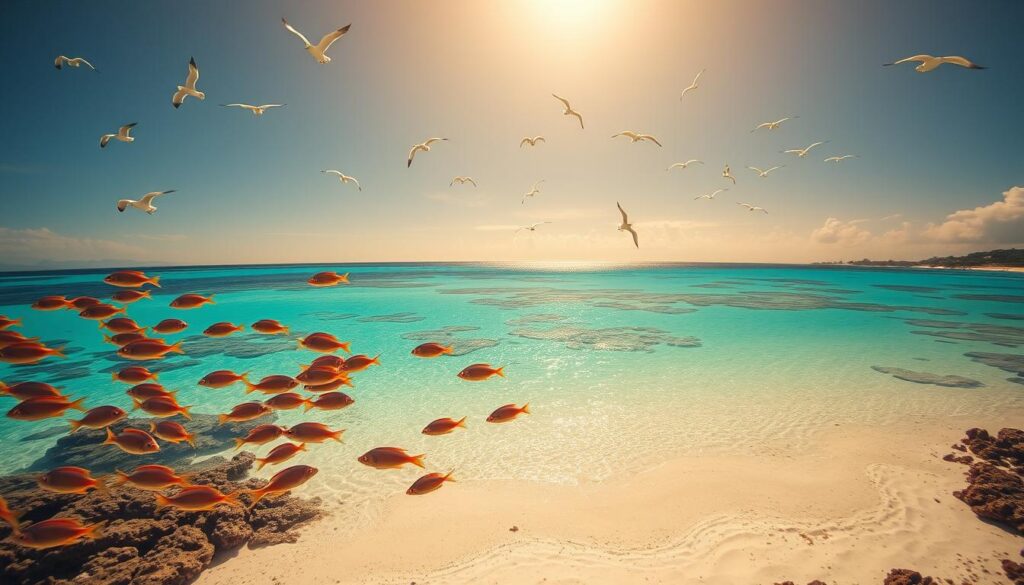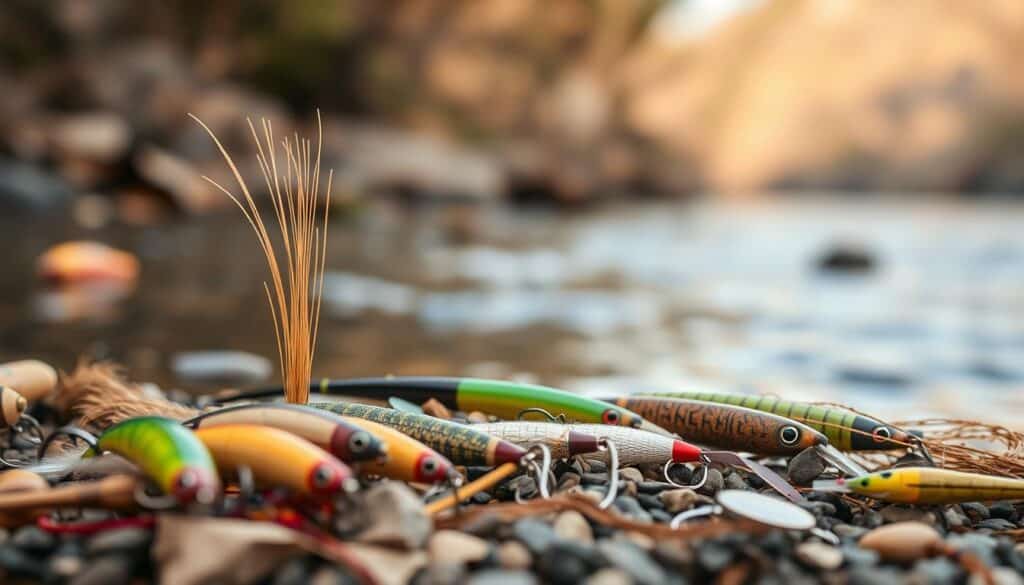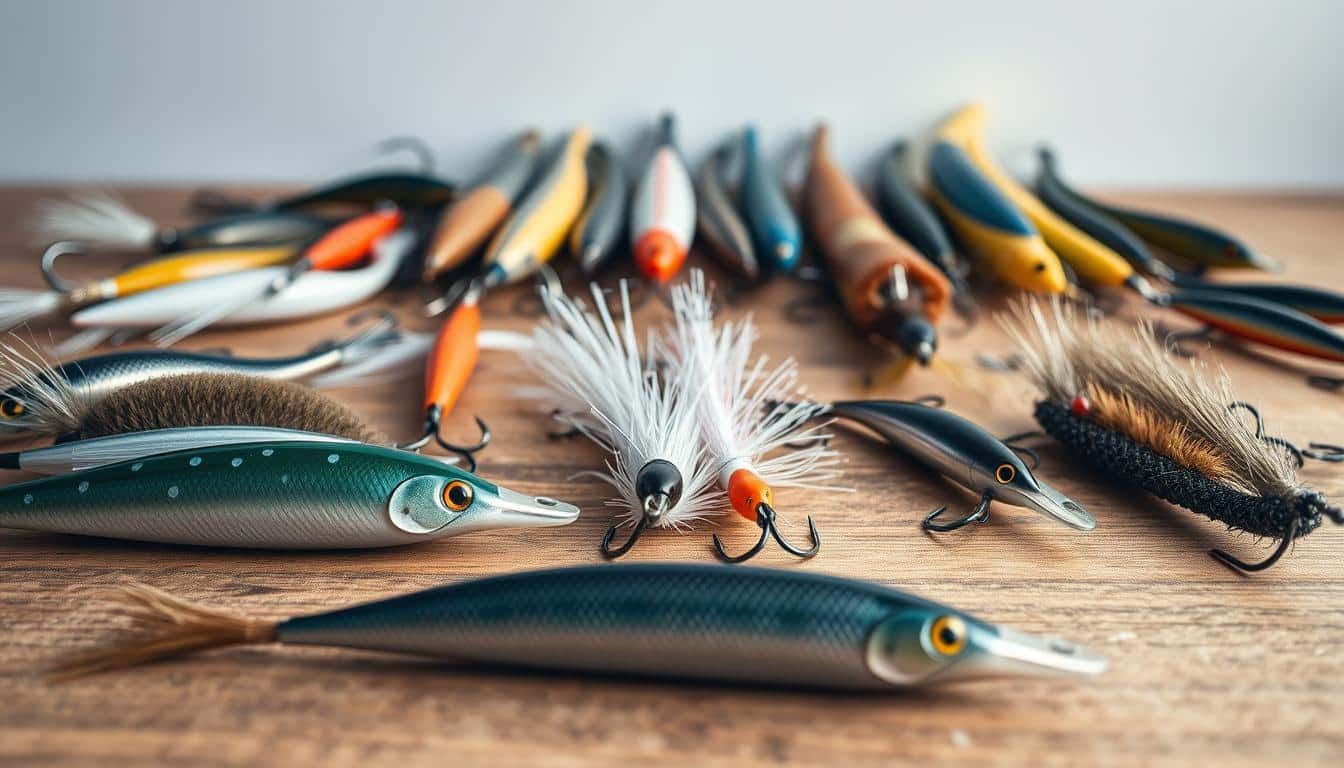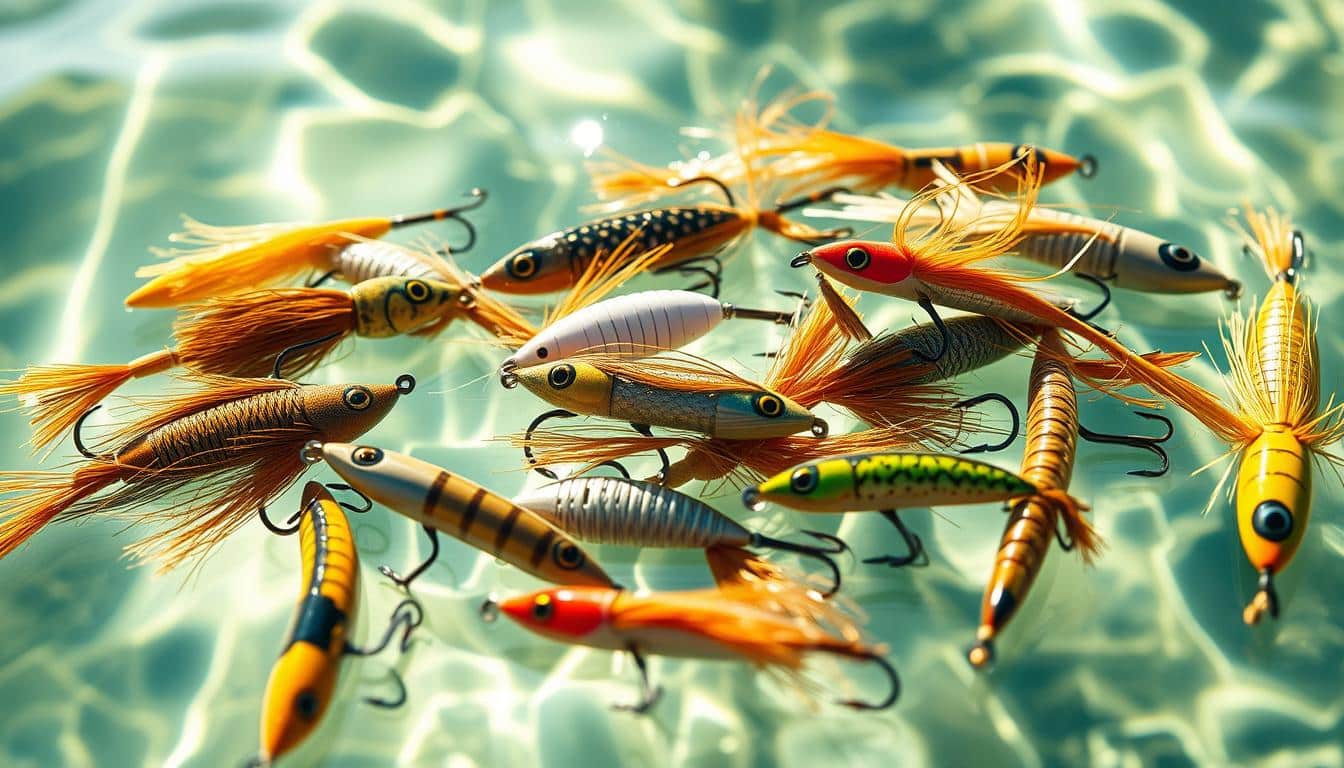Using sustainable lures and gear without plastic can help lessen microplastic pollution. Wise Angler’s study finds the fishing industry produces about 640,000 tons of plastic waste yearly. This includes thrown away gear, single-use packaging, and items used on board.
Research teams worldwide, led by Renner, Straffella, and Thanigaivel, report that millions of tons of plastic enter our oceans each year. Most of these are tiny particles smaller than 5 mm. These microplastics can travel far, harming animals and people.
For everyone who fishes, using manufactured baits and lures adds to pollution. The packaging they come in does too.
This piece explains why using fishing gear that doesn’t contain plastic is a good step. It shows that eco-friendly lures, better designs, and changing how anglers act can help. Together, these can reduce waste from fishing and protect our waters.
How Plastic-Free Lures Reduce Microplastic Pollution
Microplastic pollution involves tiny plastic fragments less than 5 mm. These come from small items like beads or break down from bigger ones. They travel across the globe via water and air. Settling in the ocean bottom, they create a hidden layer. Studies found these tiny particles from the equator to icy seas, floating or inside sea creatures.
Overview of microplastic spread in freshwater and marine systems
Microplastics in freshwater come from city runoff, wastewater, and air. They can flow into oceans or gather in lakes. In the sea, currents spread them far, even concentrating in certain areas. Creatures like mussels and fish end up eating these plastics. This leads to plastics moving up the food chain.
Why anglers and their gear matter as a source
Many people enjoy fishing around the world. They use baits and lures that can add plastics directly to water. Research found some fishing baits have plastic bits. This means each use adds plastics to the environment. Not to mention the fishing lines and lures left behind.
- Angling pollution sources include lost tackle, bait residues, and packaging waste.
- Average bait use per angler can be several kilograms per year; some anglers use far more.
- Fishing-related plastic waste contributes to broader marine microplastics and freshwater microplastics burdens.
By knowing the sources of angling pollution, we can find solutions. Using lures without plastic and less single-use bait packages help. This reduces the chance of adding more plastics to the waters.
The scale of microplastic contamination from fishing gear and baits
Fishing gear pollution comes from many sources. Lost nets, broken lines, and single-use packaging add to it. Small lakes with a lot of fishing get more pollution, especially during peak times.
To measure plastic pollution from fishing, we have to connect waste to how fast it breaks down. Wise Angler says commercial and recreational fishing together produce about 640,000 tons of plastic waste a year. This includes nets, traps, ropes, lines, and packaging that turn into microplastics.
Local areas can be greatly affected. A busy shoreline might have lots of microplastics after just one weekend. Also, events like tournaments add to the problem with more waste and particles from worn-out gear.
Studies have found microplastics in fishing baits and lures. One study in Europe looked at 160 bait samples. They found 86 suspicious particles and 39 confirmed plastics in them. Most plastics were found in groundbaits and boilies, not in pellets.
- Bait contamination stats show microplastics in 13.7% of samples on average.
- Groundbait had a higher occurrence of 26.7% on average.
- Boilies had about 10% occurrence on average.
Microplastic concentrations varied a lot. On average, there were 17.4 microplastics per kg. The average mass concentration was 6.78 mg per kg. Numbers ranged from 0 to 300 microplastics per kg, and mass from 0 to 232 mg per kg.
The plastic pieces came from several types of polymer. Fragments were usually about 2.25 mm big. The plastics found were mostly polyethylene, alkyd resins, polyvinylester, polypropylene, and polyacrylate. Red and white were the most common colors.
Most pollutants come from making the ingredients and manufacturing, not just packaging. For example, PET and PE were not the main types of plastic found, pointing to sources like fishmeal or production methods as culprits.
In a place like Germany, bait-related microplastic emissions could reach up to 0.34 tons a year. While small compared to other sources, it’s still important locally. Tire wear, textiles, and road dust are much bigger problems in Europe, though.
Both the amount and timing of plastic pollution from fishing are crucial. Plastic waste and bait microplastics can cause sudden pollution spikes. This affects fish and wildlife in shore areas and shallow waters.
Material differences: plastic vs plastic-free lure construction
The materials used in lures affect how they work and their risk to the environment. Conventional lure plastics are chosen for being budget-friendly, moldable, and flexible. But, there are dangers when these materials break down or release chemicals into the water.
Common polymers and additive risks
Polyethylene and polypropylene are often used in soft baits. They resist water and wear well. Yet, over time, they can break down into harmful microplastics. The packaging often includes PET films that also release tiny plastic particles.
Additives in baits include pigments and plasticizers. They can come off as particles or release toxic chemicals. These substances are harmful, especially if wildlife is exposed to them in addition to the plastic pieces.
- Polyethylene and polypropylene: durable, lightweight, prone to fragmentation.
- Pigments and alkyd resins: provide finish and color, create additive-release pathways.
- Reclaimed plastics: lower virgin demand but still risk microplastic generation.
Alternative materials for plastic-free lures
Using non-plastic parts can help reduce microplastic pollution. Crankbaits from sustainable wood and durable metal spoons don’t add microplastics to the environment. Also, metals like brass and stainless steel can be recycled easily.
Natural fibers are good for parts like skirts. They decompose naturally, lowering pollution. Biodegradable materials like PLA are also used in some products. But, they need to be disposed of correctly to be eco-friendly.
- Wood and metal options increase durability and lower fragmentation risk.
- Natural fiber components offer biodegradability for soft parts.
- Biopolymers and compostable packaging must meet certifications to be effective.
Designers face challenges in creating eco-friendly lures. Metals and woods can alter a lure’s behavior in water. Products made to decay need special care. Testing and reviewing a product’s full life can help make lures less harmful to the planet.
How design and packaging changes reduce microplastic emission
Small changes in how lures are designed and packaged can help stop microplastics from getting into our water. By thinking carefully about the products and how they’re made, we can prevent them from breaking easily, shedding bits, and becoming unnecessary waste.
Design strategies to minimize loss and fragmentation
Think about making lures last longer. By strengthening the parts that join together, using tougher hooks, and improving how weights are attached, lures won’t fall apart so easily. This stops tiny bits from breaking off.
Let’s use parts you can replace. If lures are made to let anglers change parts without throwing the whole thing away, and by choosing biodegradable materials, we cut down on waste.
Get rid of small parts that easily come off and avoid finishes that chip. By opting for treatments that don’t flake, we lessen the risk of small pieces entering the water. Promoting parts you can fix instead of throwing away the whole lure is also key.
Packaging and supply-chain shifts that cut single-use plastics
Retailers and brands have a big role. They can pick alternative packaging that uses less plastic. Things like cardboard, recyclable pouches, and compostable materials are great choices for fishing products instead of traditional plastic packaging.
- Choosing bulk options or refillable packs for tackle and lures means less throwaway plastic.
- Auditing suppliers and catching paint flakes and plastics in the making stage keeps products cleaner.
- Setting up systems for taking used items back and easy-to-take-apart designs support recycling and reuse.
When everyone uses minimal packaging that can be verified as environmentally friendly, the whole network cuts down on throwaway plastics. Brands that limit extra packaging help prevent both direct microplastic pollution and the eventual breakdown into smaller pieces from lost or broken fishing gear.
Behavioral changes among anglers that amplify plastic-free benefits
Small changes in how anglers act every day can reduce microplastic loss. Things like better habits on land and water help cut down litter. They also make eco-friendly products stand out in stores. When they choose to buy without plastic, it encourages the market to change.
Proper disposal and reuse
- Recycle metal split rings, hooks, and non-toxic components at local drop-offs.
- Compost certified compostable packaging and natural-fiber pieces instead of tossing them on beaches.
- Use reusable tackle boxes and refillable bait containers rather than single-use bags.
- Repair wooden lures and replace hardware to extend life and avoid early disposal.
Gear retrieval and on-water care
- Practice knot checks and gentle landing to avoid snapped lines and lost lures.
- Collect visible debris when leaving a site and bring line-recycling containers on trips.
- Participate in or organize shoreline cleanups and report frequent gear-loss spots to local managers.
Stewardship and angler education
- Share that some baits contain microplastics and that lowering bait application reduces contamination.
- Join citizen science programs to monitor shoreline litter and microplastic hotspots.
- Teach new anglers basic maintenance and responsible disposal to make good habits standard.
Consumer influence and market signals
- Retail demand shapes what stores stock; choosing to buy plastic-free lures nudges retailers toward sustainable brands.
- Clubs, guides, and charter operators can adopt procurement policies favoring durable, repairable tackle to amplify consumer influence.
- Requesting minimal or compostable packaging at point of sale encourages suppliers to change supply chains.
When anglers pick up their gear, dispose of things the right way, and choose reusable items, everyone notices. Companies and stores see what’s happening. They start to offer more options without plastic. This helps everyone and supports the move to plastic-free products.
Environmental and health benefits of reducing microplastic inputs
Less microplastic means our water and wildlife thrive. We can help by using less plastic for fishing. This keeps our lakes, rivers, and coasts cleaner. It supports food webs and protects habitats.

Reduced ingestion and entanglement for marine and freshwater species
With fewer microplastics, wildlife eats fewer harmful particles. This is true for many animals, from small fish to predators. Studies have found plastics in species like carp, mainly from certain types of feeding.
Less plastic also means animals get tangled less often. Things like lost fishing gear hurt birds, turtles, and mammals. Removing these threats lowers the chances of injuries and deaths from entanglements.
Lowered bioaccumulation and potential human exposure
Reducing microplastics keeps them from moving up the food chain. This makes seafood safer by lowering harmful particles. It also reduces our exposure to microplastics from our meals and water.
- Less microplastics mean they can’t carry as many harmful chemicals.
- Making life safer for wildlife reduces stress on their growth and reproduction.
- Humans face fewer health risks from microplastics, which is better for our diets in the long run.
Cutting back on plastic and excess nutrients helps control algae growth. This action cleans up small lakes and ponds and helps fish like carp stay healthier.
Using less plastic stops it from carrying harmful substances. This move protects our ecosystems and keeps seafood safe for everyone, whether they live near the coast or inland.
Evidence and case studies supporting plastic-free transitions
Industry pilots and studies show the impact of packaging changes on microplastic levels. They reveal where most contamination happens. This section looks at the efforts and trials for plastic-free options.
Industry examples and pilot programs
Wise Angler moved to a circular approach with compostable packaging and plastic-free delivery. They stopped using shrink wrap and bubble mailers. They also made changes in their supply chain to avoid plastic use.
- Some retailers and manufacturers are testing compostable materials and tracking their packaging’s losses.
- These pilot programs have seen a drop in single-use waste and less packaging debris.
- In some places, local collection plans are used alongside pilot programs to track litter changes over time.
Research findings on bait contamination and local impacts
A study on bait found microplastics in groundbaits and boilies but not in pellet samples. It analyzed 160 samples from 16 products.
- There are differences in microplastic levels based on the type of product and manufacturing process.
- Products with more plant-based ingredients had higher microplastic counts, suggesting a risk in raw materials.
- Estimates show bait use has local environmental impacts that need addressing.
Improved monitoring methods are helping to better identify and trace microplastics. Techniques like Micro-FTIR and Raman spectroscopy can spot very small polymers. Also, environmental DNA helps track microbes and movement paths.
In Europe, monitoring efforts and citizen science are key to these pilot programs. They provide data to see if changes in packaging, like compostable options, help reduce microplastics from bait.
Together, these studies and programs offer ways for brands, officials, and fishermen to fight pollution from packaging and products.
Practical guide for anglers: choosing and using plastic-free lures
Choosing the right gear is crucial for protecting water and fish. This guide helps you pick and use plastic-free lures correctly. It shows how to reduce microplastics and keep your gear in good shape. This benefits both you and the environment.

What to look for when buying plastic-free lures and tackle
- Check labels for materials like wood, metal, or natural fibers. For biopolymers, look for compostability certifications such as AS 4736 or DIN standards.
- Opt for eco-friendly packaging. Avoid plastic wraps and blister packs.
- Choose brands that share their supply chain details and offer repair services. Companies like Wise Angler are leading the way in plastic-free efforts.
- Go for lures that you can fix by replacing hooks or other parts. This way, you don’t have to throw away the whole thing if a part breaks.
- Seek out products with data on microplastic safety or those verified by third parties.
Field tips to minimize microplastic release while fishing
- Be precise with your baiting to avoid excess material in the water.
- Use strong knots and the right gear to prevent losing tackle.
- Pick up any lost gear or litter from fishing areas.
- Fix up lures made of wood or metal instead of throwing them away.
- Recycle or compost what you can, and support local recycling programs.
- Help out with local cleanups to keep fishing spots clean.
Quick purchase checklist
- Material = Choose wood, metal, natural fiber, or certified compostable biopolymers.
- Packaging = Go for options that are recycled, recyclable, or compostable.
- Brand = Look for those with clear practices and repair programs.
- Performance = Ensure durability and the availability of replaceable parts.
By following these tips, you can choose sustainable fishing gear more easily. Making small changes in what gear you buy and how you fish can make a big difference. These best practices help protect our waters and keep your gear usable for longer.
Conclusion
Fishing-related plastics, like lost gear and one-use packaging, add loads of microplastics to water. Studies say around 640,000 tons each year. Research on bait products shows lots of waste and microplastic bits. It’s clear we need to cut down on this kind of pollution.
Switching to non-plastic lures and sustainable fishing habits can make a big change. Using materials that last longer, and packaging that can break down naturally helps. Retail programs, like those by Wise Angler, show how choosing different packaging and products can lessen plastic use.
Fishers who pick up their gear, fix their stuff, and use cleaner baits make a big difference. Science helps too, using tests and surveys to show where changes are needed. This helps make fishing gear and practices better for the environment.
For fishing that doesn’t harm the planet, people in the U.S. who fish, sell fishing gear, or make it, should choose alternatives to plastic. They should use packaging that’s easy on the earth, want more openness from brands, and take care of our waters. These actions will cut down on microplastic pollution, save our water life, and keep people healthy. It’s all part of making fishing more eco-friendly across the country.
FAQ
What is the central claim about plastic-free lures and angling products?
How are microplastics defined and where do they come from?
Why do lures, bait and angling products matter as pollution sources?
How much plastic waste does the global fishing sector produce?
What evidence shows microplastics in manufactured baits?
What polymers and particle types were found in baits?
Are packaging plastics the main source of bait contamination?
How do bait‑derived microplastic emissions compare to other sources?
What conventional materials and additives in lures pose microplastic risks?
What plastic‑free material alternatives exist for lures and tackle?
What trade‑offs should anglers and manufacturers expect with plastic‑free materials?
What design strategies reduce microplastic release from lures?
How can packaging and supply chains be changed to cut single‑use plastics?
What angler behaviors reduce microplastic emissions on the water?
How can consumer choices influence manufacturers and retailers?
What ecological and human‑health benefits follow reduced microplastic inputs?
Are there documented industry and research examples supporting plastic‑free transitions?
How are microplastics detected and monitored?
What should anglers look for when buying plastic‑free lures and tackle?
What simple field tips minimize microplastic release while fishing?
Does reducing angling‑related plastics make a measurable difference?
Where can anglers and retailers start to implement these changes?
Content created with the help of Artificial Intelligence.



